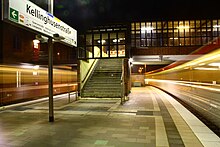Kellinghusenstrasse underground station
| Kellinghusenstrasse | |
|---|---|
| Metro station in Hamburg | |

|
|
| Basic data | |
| District | Hamburg-Eppendorf |
| Opened | 05/10/1912 |
| Tracks (platform) | 4 tracks 2 platforms |
| Coordinates | 53 ° 35 '19 " N , 9 ° 59' 28" E |
| use | |
| Line (s) |
|
| Switching options |
|
| Passengers | 83,100 / day (Mon-Fri, 2017) |
The Kellinghusenstrasse underground station is a hub of the Hamburg underground network . It is used by an average of 83,100 passengers every day (Mon – Fri, 2017). The abbreviation of the station at the operating company Hamburger Hochbahn is "KE".
structure
Kellinghusenstraße is the junction of the underground lines U1 and U3 in the Eppendorf district on the eponymous Kellinghusenstraße . The stop is located on the embankment and has two platforms with a total of four tracks. A directional operation is carried out, i.e. the trains on both lines stop in the same direction (in and out of town) on the same platform. The inner tracks are used by the U1, the outer ones by the U3 trains. With a few exceptions, the timetable provides for a direct transition. There are two sidings south of the stop. Today they are mainly used in the event of operational disruptions in order to turn trains .
Overpass structures were erected on both sides of the facility in order to be able to carry out the crossings required for directional operation without any height .
The two platforms are connected at both ends. At the south end there is a glass, closed bridge, which was designed by Walther Puritz . At the north end, the platform can be changed via the entrance structure below the platforms.
Usage figures
On weekdays (Mon-Fri) the U1 line recorded an average of 42,700 passengers boarding or disembarking at the stop in 2018. The U3 used around 40,500 passengers boarding or disembarking.
history
The construction of the Kellinghusenstrasse stop was started between 1909 and 1910 by Raabe & Wöhlecke in the historicist style and decorated with stone reliefs by Johann Michael Bossard . In 1912, train operations began on what was then the ring line (now the U3), and in 1914 traffic on the branch line towards Ohlsdorf (now the U1) began. In 1931 the so-called " KellJung-Linie " was opened from Kellinghusenstraße to Jungfernstieg . The trains coming from Ohlsdorf now continued on this route directly to the city center. To make it easier to change between the two lines, an additional bridge was built by Walther Puritz in 1926 .
In the years 2009 to 2010 the platform roofs were torn down due to dilapidation and, extended by 25 meters, rebuilt. The platform bridge was largely rebuilt in 2013/2014 and looks almost like the original. Since February 2012, elevators have been leading to the platforms, making the trains barrier-free.
Connection
At the Kellinghusenstraße underground station there is a transition to the Metrobus lines 22 in the direction of Blankenese, 25 in the direction of Altona and Hammerbrook and 26 in the direction of Rahlstedt. There is a StadtRAD Hamburg station in front of the stop, as well as a large bicycle parking facility for underground passengers who come by bike.
literature
- Friedhelm Grundmann : Kellinghusenstraße - building with history . In: stations in Hamburg architecture . Hamburger Hochbahn AG, Hamburg 2008, ISBN 978-3-9812591-0-0 , p. 11-18 .
- Sven Bardua: Longer life for a modern gem: the Kellinghusenstraße platform bridge . In: Architecture in Hamburg: Yearbook 2014 . Hamburg 2014, ISBN 978-3-88506-040-6 , pp. 86 f .
Web links
- Kellinghusenstraße on hamburger-untergrundbahn.de ( Memento from June 9, 2017 in the Internet Archive )
Individual evidence
- ↑ a b Answer of the Hamburger Hochbahn from December 17, 2018 to an inquiry about the Hamburg Transparency Act. In: fragdenstaat.de, accessed on February 2, 2019.
- ↑ The basis is the entry and exit numbers for an average working day (Mon-Fri) 2018 according to information from HVV in an answer to "FragDenStaat", accessed on September 16, 2019 .


